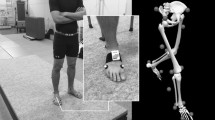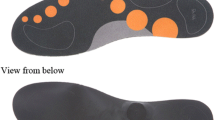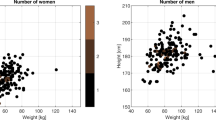Abstract
In studies of gait, continuous measurement of force exerted by the ground on a body, or ground reaction force (GRF), provides valuable insights into biomechanics, locomotion, and the possible presence of pathology. However, gold-standard measurement of GRF requires a costly in-lab observation obtained with sophisticated equipment and computer systems. Recently, in-shoe sensors have been pursued as a relatively inexpensive alternative to in-lab measurement. In this study, we explore the properties of continuous in-shoe sensor recordings using a functional data analysis approach. Our case study is based on measurements of three healthy subjects, with more than 300 stances (defined as the period between the foot striking and lifting from the ground) per subject. The sensor data show both phase and amplitude variabilities; we separate these sources via curve registration. We examine the correlation of phase shifts across sensors within a stance to evaluate the pattern of phase variability shared across sensors. Using the registered curves, we explore possible associations between in-shoe sensor recordings and GRF measurements to evaluate the in-shoe sensor recordings as a possible surrogate for in-lab GRF measurements.














Similar content being viewed by others
References
Benedetti M, Merlo A, Leardini A (2013) Inter-laboratory consistency of Gait analysis measurements. Gait Posture 38(4):934–939
Bilodeau RA, Fullwood DT, Colton JS, Yeager JD, Bowden AE, Park T (2015) Evolution of nano-junctions in piezoresistive nanostrand composites. Compos Part B Eng 72:45–52
Crane EA, Cassidy RB, Rothman ED, Gerstner GE (2010) Effect of registration on cyclical kinematic data. J Biomech 43(12):2444–2447
Daoud AI, Geissler GJ, Wang F, Saretsky J, Daoud YA, Lieberman DE (2012) Foot strike and injury rates in endurance runners: a retrospective study. Med Sci Sports Exerc 44(7):1325–1334
Earls C, Hooker G (2017) Combining functional data registration and factor analysis. J Comput Graph Stat 26(2):296–305
Earls C, Hooker G (2017) Variational bayes for functional data registration, smoothing, and prediction. Bayesian Anal 12(2):557–582
Gasser T, Kneip A (1995) Searching for structure in curve samples. J Am Stat Assoc 90(432):1179–1188
Goldsmith J, Greven S, Crainiceanu C (2013) Corrected confidence bands for functional data using principal components. Biometrics 69(1):41–51
Goldsmith J, Scheipl F, Huang L, Wrobel J, Gellar J, Harezlak J, McLean MW, Swihart B, Xiao L, Crainiceanu C, Reiss PT (2016) Refund: regression with functional data. R package version 0.1-16. https://CRAN.R-project.org/package=refund
Hausdorff JM, Cudkowicz ME, Firtion R, Wei JY, Goldberger AL (1998) Gait variability and basal Ganglia disorders: stride-to-stride variations of Gait cycle timing in Parkinson’s disease and Huntington’s disease. Mov Disord 13(3):428–437
Hausdorff JM, Peng CK, Goldberger AL, Stoll AL (2004) Gait unsteadiness and fall risk in two affective disorders: a preliminary study. BMC Psychiatry 4(1):39
Helwig NE, Hong S, Hsiao-Wecksler ET, Polk JD (2011) Methods to temporally align Gait cycle data. J Biomech 44(3):561–566
Hyldahl RD, Evans A, Kwon S, Ridge ST, Robinson E, Hopkins JT, Seeley MK (2016) Running decreases knee intra-articular cytokine and cartilage oligomeric matrix concentrations: a pilot study. Eur J Appl Physiol 116(11–12):2305–2314
Johnson OK, Kaschner GC, Mason TA, Fullwood DT, Hansen G (2011) Optimization of nickel nanocomposite for large strain sensing applications. Sens Actuators A Phys 166(1):40–47
Karamanidis K, Arampatzis A, Brüggemann GP (2004) Reproducibility of electromyography and ground reaction force during various running techniques. Gait Posture 19(2):115–123
Kneip A, Gasser T (1992) Statistical tools to analyze data representing a sample of curves. Ann Stat 20:1266–1305
Kneip A, Ramsay JO (2008) Combining registration and fitting for functional models. J Am Stat Assoc 103(483):1155–1165
Kneip A, Li X, MacGibbon K, Ramsay J (2000) Curve registration by local regression. Can J Stat 28(1):19–29
Marron J, Ramsay JO, Sangalli LM, Srivastava A (2014) Statistics of time warpings and phase variations. Electr J Stat 8(2):1697–1702
Marron JS, Ramsay JO, Sangalli LM, Srivastava A (2015) Functional data analysis of amplitude and phase variation. Stat Sci 30(4):468–484
Merrell AJ, Fullwood DT, Bowden AE, Remington TD, Stolworthy DK, Bilodeau A (2013) Applications of nano-composite piezoelectric foam sensors. In: ASME 2013 conf on smart materials, adaptive structures and intelligent systems
Owings TM, Grabiner MD (2004) Variability of step kinematics in young and older adults. Gait Posture 20(1):26–29
Peter A, Rangarajan A (2006) Shape analysis using the Fisher-Rao Riemannian metric: unifying shape representation and deformation. In: 3rd IEEE international symposium on biomedical imaging: nano to macro, 2006. IEEE, pp 1164–1167
Pietrosimone B, Loeser RF, Blackburn JT, Padua DA, Harkey MS, Stanley LE, Luc-Harkey BA, Ulici V, Marshall SW, Jordan JM (2017) Biochemical markers of cartilage metabolism are associated with walking biomechanics 6-months following anterior cruciate ligament reconstruction. J Orthop Res 35:2288–2297
Ramsay J, Li X (1998) Curve registration. J R Stat Soc Ser B 60(2):351–363
Ramsay JO (1998) Estimating smooth monotone functions. J R Stat Soc Ser B 60(2):365–375
Rice H, Jamison S, Davis I (2016) Footwear matters: influence of footwear and foot strike on load rates during running. Med Sci Sports Exerc 48(12):2462–2468
Rosquist PG, Collins G, Merrell AJ, Tuttle NJ, Tracy JB, Bird ET, Seeley MK, Fullwood DT, Christensen WF, Bowden AE (2017) Estimation of 3d ground reaction force using nanocomposite piezo-responsive foam sensors during walking. Ann Biomed Eng 45:2122–2134
Sadeghi H, Allard P, Shafie K, Mathieu PA, Sadeghi S, Prince F, Ramsay J (2000) Reduction of gait data variability using curve registration. Gait Posture 12(3):257–264
Sadeghi H, Mathieu PA, Sadeghi S, Labelle H (2003) Continuous curve registration as an intertrial gait variability reduction technique. IEEE Trans Neural Syst Rehabil Eng 11(1):24–30
Scheipl F, Staicu AM, Greven S (2015) Functional additive mixed models. J Comput Graph Stat 24(2):477–501
Seeley MK, Son SJ, Kim H, Hopkins JT (2017) Walking mechanics for patellofemoral pain subjects with similar self-reported pain levels can differ based upon neuromuscular activation. Gait Posture 53:48–54
Seliktar R, Yekutiel M, Bar A (1979) Gait consistency test based on the impulse-momentum theorem. Prosthet Orthot Int 3(2):91–98
Silverman BW (1995) Incorporating parametric effects into functional principal components analysis. J R Stat Soc Ser B 57:673–689
Srivastava A, Klassen E, Joshi SH, Jermyn IH (2011a) Shape analysis of elastic curves in Euclidean spaces. IEEE Trans Pattern Anal Mach Intell 33(7):1415–1428
Srivastava A, Wu W, Kurtek S, Klassen E, Marron J (2011b) Registration of functional data using Fisher-Rao metric. arXiv:1103.3817
Teng HL, Wu D, Su F, Pedoia V, Souza RB, Ma CB, Li X (2017) Gait characteristics associated with a greater increase in medial knee cartilage t1\(\rho \) and t2 relaxation times in patients undergoing anterior cruciate ligament reconstruction. Am J Sports Med 45:3262–3271
Thies SB, Tresadern PA, Kenney LP, Smith J, Howard D, Goulermas JY, Smith C, Rigby J (2009) Movement variability in stroke patients and controls performing two upper limb functional tasks: a new assessment methodology. J Neuroeng Rehab 6(1):2
Tucker JD, Wu W, Srivastava A (2013) Generative models for functional data using phase and amplitude separation. Comput Stat Data Anal 61:50–66
Tucker JD, Wu W, Srivastava A (2014) Analysis of proteomics data: phase amplitude separation using an extended Fisher-Rao metric. Electron J Stat 8(2):1724–1733
Wu W, Srivastava A (2014) Analysis of spike train data: alignment and comparisons using the extended Fisher–Rao metric. Electron J Stat 8(2):1776–1785
Yao F, Müller HG, Wang JL (2005) Functional data analysis for sparse longitudinal data. J Am Stat Assoc 100(470):577–590
Acknowledgements
This work was supported in part by NSF CMMI Award #1538447. The last author’s research was supported by the Award #R01HL123407 from the National Heart, Lung, and Blood Institute, and by the Award #R01NS097423-01 from the National Institute of Neurological Disorders and Stroke.
Author information
Authors and Affiliations
Corresponding author
Appendix
Appendix
In Sect. 4.4, we apply functional analysis methods to examine the association between VGRF measurement and in-shoe sensor curves for Subject 2; here, we present the results of functional regression models for Subjects 1 and 3.
Analogous to Fig. 7, Fig. 11 shows the correlations between VGRF and in-shoe sensor curves for Subjects 1 and 3. Similar to Subject 2, these two subjects show neither a clear off-diagonal band nor an obvious peak along the diagonal.
The results in Fig. 12 of cross-validation study for Subjects 2 and 3 are similar to those in Fig. 8 from the main manuscript. For both Subjects 1 and 3, the heel seems most useful, but the model with all four predictors performs the best.
Figures 13 and 14 are analogous to Figs. 9, and 10 in the main manuscript, respectively. Rows in Fig. 13 show the estimated coefficients of function-on-function regression models with all four in-shoe sensors as predictors for Subjects 2 and 3. The estimated coefficients are distinctively different across subjects, implying the unique relationship between VGRF and in-shoe sensors for each subject.
Rights and permissions
About this article
Cite this article
Lee, J., Li, G., Christensen, W.F. et al. Functional Data Analyses of Gait Data Measured Using In-Shoe Sensors. Stat Biosci 11, 288–313 (2019). https://doi.org/10.1007/s12561-018-9226-3
Received:
Revised:
Accepted:
Published:
Issue Date:
DOI: https://doi.org/10.1007/s12561-018-9226-3




